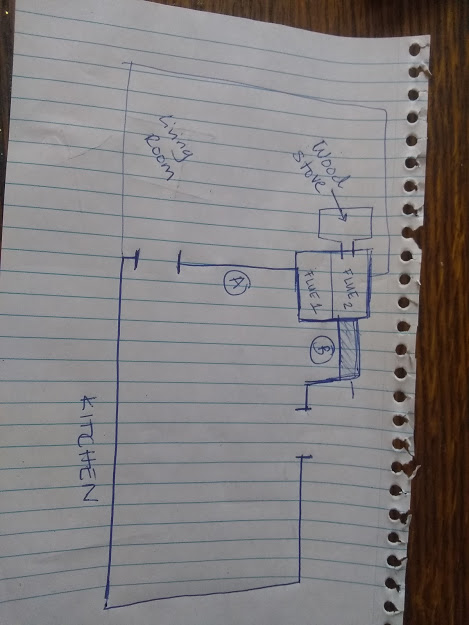I'm going to be putting a wood cook stove in my kitchen. Here's a map with the two possible locations (A and B).
![[Hearth.com] Wood cook stove -- what's the best location? [Hearth.com] Wood cook stove -- what's the best location?](/talk/proxy.php?image=https%3A%2F%2Fphotos.google.com%2Fshare%2FAF1QipOxsMuOJNVyMv21CgLGQuXnsROQ9bCoyI4qctl3zuFZs9Fp9vcQtwRf346hKpmxAA%3Fkey%3DVDF2dTlSUXpNTUNpN0ZuREViUDViMDZmMGhBUl9n&hash=4265d36bff3dce92520006d0639549d8)
The little nook (B) is where I believe the original Colonial-era open hearth cooking area was (based on the location of enormous foundation in cellar and no point of that nook). To the left of the nook is the chimney. Flue 2 already has a wood stove in it in the living room (Fisher FP insert, yay Fisher!). Flue 1 has a thimble opening where a wood cook stove used to be located (location A).
The little nook is the warmest place in my house, so my thought was to put the stove there, since the nook is pretty much dead weird space and I thought it would radiate more heat. But, where the word kitchen is written is the north side of the house and very cold. So if the wood stove had the firebox on the left, would it pump more heat into the house and compensate for that cold north area?
I'm looking at old, vintage-type stoves. I currently have a propane range in location A and will continue to use propane (which can get moved around) as a secondary/summer cooking source.
The walls are knotty pine wood paneling, so I'll have to have a heat shield in either location, I guess.
Thanks for any ideas!
The little nook (B) is where I believe the original Colonial-era open hearth cooking area was (based on the location of enormous foundation in cellar and no point of that nook). To the left of the nook is the chimney. Flue 2 already has a wood stove in it in the living room (Fisher FP insert, yay Fisher!). Flue 1 has a thimble opening where a wood cook stove used to be located (location A).
The little nook is the warmest place in my house, so my thought was to put the stove there, since the nook is pretty much dead weird space and I thought it would radiate more heat. But, where the word kitchen is written is the north side of the house and very cold. So if the wood stove had the firebox on the left, would it pump more heat into the house and compensate for that cold north area?
I'm looking at old, vintage-type stoves. I currently have a propane range in location A and will continue to use propane (which can get moved around) as a secondary/summer cooking source.
The walls are knotty pine wood paneling, so I'll have to have a heat shield in either location, I guess.
Thanks for any ideas!
Last edited:



![[Hearth.com] Wood cook stove -- what's the best location? [Hearth.com] Wood cook stove -- what's the best location?](https://www.hearth.com/talk/data/attachments/243/243236-5572ff173fb673fe9a7795e6f1984d29.jpg?hash=vCAciwOuo8)

